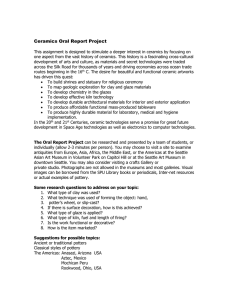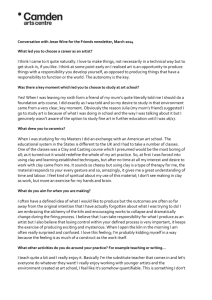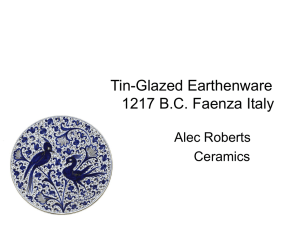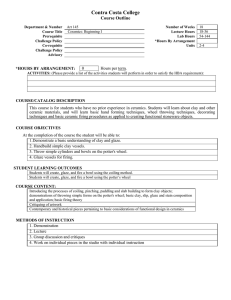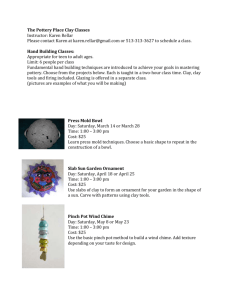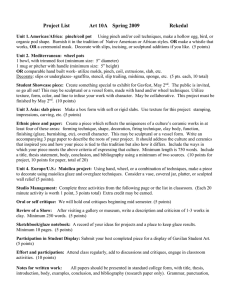Ceramics - TeacherWeb
advertisement
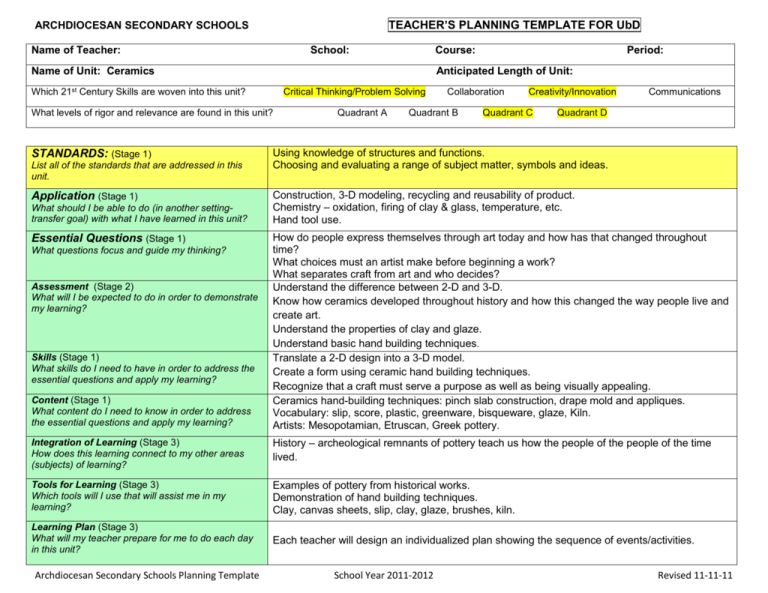
TEACHER’S PLANNING TEMPLATE FOR UbD ARCHDIOCESAN SECONDARY SCHOOLS Name of Teacher: School: Course: Name of Unit: Ceramics Anticipated Length of Unit: Which 21st Century Skills are woven into this unit? Critical Thinking/Problem Solving What levels of rigor and relevance are found in this unit? STANDARDS: (Stage 1) List all of the standards that are addressed in this unit. Application (Stage 1) What should I be able to do (in another settingtransfer goal) with what I have learned in this unit? Essential Questions (Stage 1) What questions focus and guide my thinking? Assessment (Stage 2) What will I be expected to do in order to demonstrate my learning? Skills (Stage 1) What skills do I need to have in order to address the essential questions and apply my learning? Content (Stage 1) What content do I need to know in order to address the essential questions and apply my learning? Period: Quadrant A Collaboration Quadrant B Creativity/Innovation Quadrant C Communications Quadrant D Using knowledge of structures and functions. Choosing and evaluating a range of subject matter, symbols and ideas. Construction, 3-D modeling, recycling and reusability of product. Chemistry – oxidation, firing of clay & glass, temperature, etc. Hand tool use. How do people express themselves through art today and how has that changed throughout time? What choices must an artist make before beginning a work? What separates craft from art and who decides? Understand the difference between 2-D and 3-D. Know how ceramics developed throughout history and how this changed the way people live and create art. Understand the properties of clay and glaze. Understand basic hand building techniques. Translate a 2-D design into a 3-D model. Create a form using ceramic hand building techniques. Recognize that a craft must serve a purpose as well as being visually appealing. Ceramics hand-building techniques: pinch slab construction, drape mold and appliques. Vocabulary: slip, score, plastic, greenware, bisqueware, glaze, Kiln. Artists: Mesopotamian, Etruscan, Greek pottery. Integration of Learning (Stage 3) How does this learning connect to my other areas (subjects) of learning? History – archeological remnants of pottery teach us how the people of the people of the time lived. Tools for Learning (Stage 3) Which tools will I use that will assist me in my learning? Examples of pottery from historical works. Demonstration of hand building techniques. Clay, canvas sheets, slip, clay, glaze, brushes, kiln. Learning Plan (Stage 3) What will my teacher prepare for me to do each day in this unit? Each teacher will design an individualized plan showing the sequence of events/activities. Archdiocesan Secondary Schools Planning Template School Year 2011-2012 Revised 11-11-11 Archdiocesan Secondary Schools Planning Template School Year 2011-2012 Revised 11-11-11
